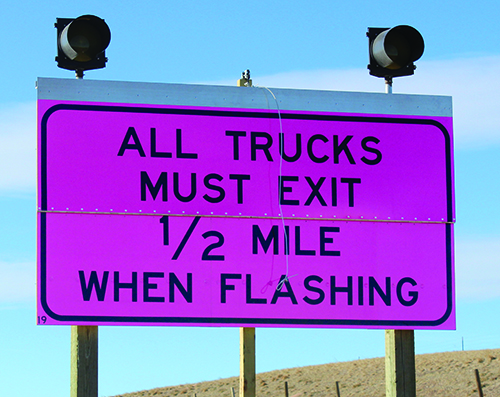- Home
- Administration
- Aeronautics
- Business with WYDOT
- Construction Projects
- Driver License and Records
- Economic Stimulus Projects (ARRA - TIGER)
- Engineering and Technical Programs
- Fuel Tax
- Highway Safety
- Human Resources
- Manuals and Publications
- News and Information
- Permits
- Planning/Projects/Research
- Titles, Plates and Registration
- Travel
- Trucking / Commercial Vehicles
- Vehicle Business Regulation
- Wyoming Highway Patrol
- Search
- Sitemap
WYDOT installs new signs on I-25 to help reduce blowovers
January 14, 2019
 WYDOT has installed new signs on Interstate 25 south of Cheyenne to be used during some high wind events – the product of more than a year of planning and action to reduce the number of blowovers on that section of highway.
WYDOT has installed new signs on Interstate 25 south of Cheyenne to be used during some high wind events – the product of more than a year of planning and action to reduce the number of blowovers on that section of highway.
The fluorescent pink-colored “incident management” signs are located in the southbound lanes between College Drive (Exit 7) and High Plains Road (Exit 4).
They’re typically flipped closed, but during a high-wind event, they can be opened and used to help sort passenger vehicles from large commercial vehicles and those with trailers.
When wind gusts are around 60 mph or more and the wind direction is likely to cause blowovers, the traffic sort option may be used. In that scenario, the Wyoming Highway Patrol will force all trucks and trailers to exit at High Plains Road, while passenger vehicles are allowed to continue south in the left lane. WHP personnel, with the assistance of WYDOT maintenance, will then sort the trucks at the interchange, allowing those that do not pose a blowover risk to continue south, and making the rest stay in Cheyenne and either wait out the wind event or find an alternate route.
The entire effort is coordinated with the Colorado Department of Transportation, which has a similar plan to sort northbound traffic at the Owl Canyon Road exit north of Wellington, Colorado.
The new procedure follows an increasing number of blowover incidents on I-25 beginning in 2017. WYDOT, WHP, CDOT, and the Colorado State Patrol all coordinated to develop a plan to implement the traffic sort.
Wyoming has had a “high and light” closure system in place for some time, but it relies on drivers of high profile and lightweight vehicles to make the decision about whether or not it’s too risky to proceed.
But more drivers are ignoring the high and light closure completely, said WHP Division A Supervisor Lt. Tim Romig and District 1 Commander Capt. Tom Stoker.
Exactly why drivers ignore the law can be due to a number of causes, including inexperienced drivers or language barriers, but Stoker said one reason for drivers ignoring the “high and light” closure is due to the changing nature of the logistics business.
“It’s just-in-time delivery anymore,” he said, adding that empty trucks are akin to money not being made. “They’re thinking, ‘if I can sneak by this time, I can get down there and get loaded and start earning.’”
The event that really pushed the traffic sort idea to fruition was a road closure on I-25 last fall, when CDOT asked WYDOT to shut down the interstate due to a blown over truck blocking the southbound lanes in Colorado.
“It was a hard closure,” Stoker said. “Nobody was allowed to go down 25.”\
But drivers were not happy.
“We got a lot of negative feedback about why we are blocking the whole road and no cars could proceed,” Stoker said.
Following the incident, agencies in Wyoming (WHP and WYDOT) and Colorado (CSP and CDOT) continued to have conversations with one another about how to try to prevent as many blowovers as possible while keeping the transportation system flowing.
CSP and CDOT did an initial traffic sort at Wellington, Colorado, last fall. WHP troopers traveled to Colorado to observe the process and see how it could be implemented in Wyoming.
WYDOT and WHP personnel experimented with different ways to separate the high blowover risk vehicles from the rest of traffic. Initially, all traffic was forced off I-25 at High Plains Road, but that method resulted in backups for southbound traffic, particularly during the evening rush hour.
After meetings and after-action reviews, WYDOT and WHP settled on the current plan.
As in the past, WYDOT and WHP begin preparing for action whenever wind gusts of around 60 mph or greater are forecasted. Once winds reach a crucial speed and direction, the closure to light and high-profile vehicles is implemented.
If the wind direction is likely to cause blowovers and weather and other conditions permit, and WHP determines a traffic sort would be the best way to prevent blowovers, the traffic sort begins.
Under the plan, two WHP troopers and one or two WYDOT maintenance units are dispatched to designated spots along I-25 and at High Plains Road. Each unit has a job to do, whether it be troopers enforcing the closure and ordering high risk vehicles to turn around or maintenance units with portable electronic message signs to assist drivers in understanding the situation.
One trooper is parked at the road closure gate on I-25 (which only blocks the right lane), and the other is stationed at the end of the exit ramp to enforce the closure to high-risk vehicles.
Maintenance has one vehicle with an electronic message sign parked along I-25 prior to High Plains Road to warn drivers about the situation ahead, which is an attempt to prevent secondary crashes, Cheyenne Maintenance Area Supervisor Don Bridges said. Another maintenance vehicle can be stationed at the interchange to assist with traffic management.
“We’re trying to do this with as few of our people as possible in harm’s way,” he said.
Stoker said Wyoming’s traffic sort plan has the advantage of keeping high-risk vehicles off the road while causing little disruption to unaffected vehicles.
“There were a lot of people that appreciated going into the left lane and continuing on their way south,” he said. “People were honking and giving us thumbs up and waves.”
As the process for sorting traffic solidified, WYDOT decided to place permanent signs along I-25 to be used for such an event.
Several signs were installed.
The first two are on both sides of the southbound lanes at MM 7, just south of College Drive. Those read, “All trucks use right lane,” when opened.
The remaining signs continue to inform trucks of the mandatory exit at High Plains Road as they approach the interchange.
The permanent signs will be used along with the portable electronic signs from maintenance and the overhead digital message signs on I-25 and I-80.
Not every high-wind event will result in a traffic sort, however. Adverse weather conditions or other emergencies may take priority, in which case drivers will need to make a decision as to whether their vehicle will or will not constitute a blowover risk.
“If the roads are slick, that’s not what (the traffic sort) is set up for,” Romig said.
In some cases, troopers may make the decision that it is better to enforce the high and light closure by just patrolling I-25, as was the case with a recent wind event, Romig said.
The end goal is to reduce or eliminate the number of blowovers on I-25, which delay traffic and can cause damage to WYDOT’s infrastructure. By taking a proactive safety measure when circumstances allow, WHP and WYDOT are able to ensure a safer transportation system to motorists, while simultaneously protecting the property that is being moved in commerce.





